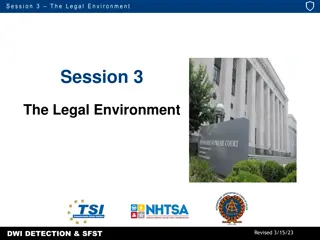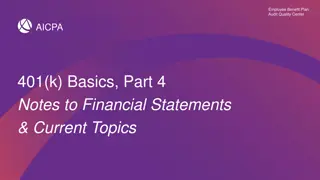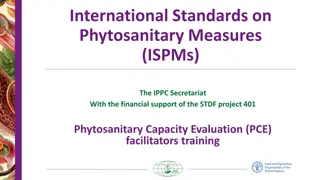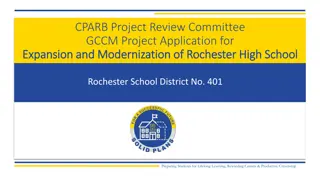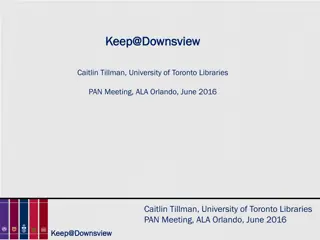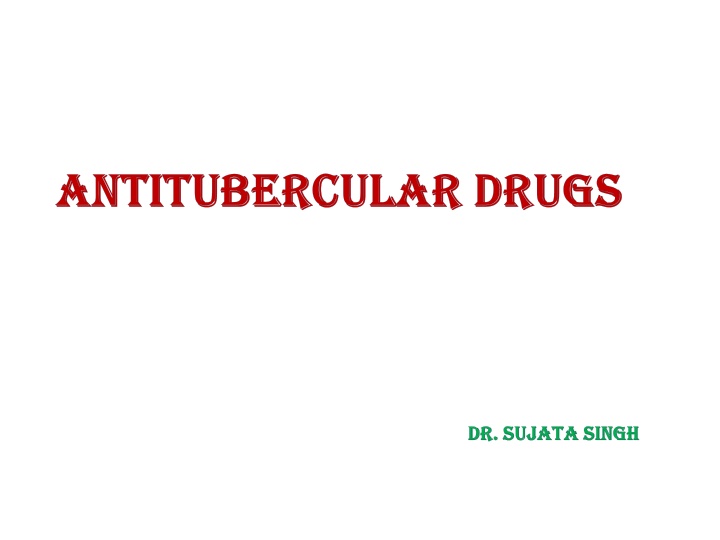
Antitubercular Drugs and Treatment Guidelines
Discover the world of antitubercular drugs, including first-line and second-line options, mechanisms of action, side effects, and dosages. Learn about the national program for tuberculosis control in India and explore newer antitubercular medications. Dive into the essential components of antitubercular regimens, such as Isoniazid's bactericidal properties and its role in tuberculosis treatment.
Download Presentation

Please find below an Image/Link to download the presentation.
The content on the website is provided AS IS for your information and personal use only. It may not be sold, licensed, or shared on other websites without obtaining consent from the author. If you encounter any issues during the download, it is possible that the publisher has removed the file from their server.
You are allowed to download the files provided on this website for personal or commercial use, subject to the condition that they are used lawfully. All files are the property of their respective owners.
The content on the website is provided AS IS for your information and personal use only. It may not be sold, licensed, or shared on other websites without obtaining consent from the author.
E N D
Presentation Transcript
ANTITUBERCULAR ANTITUBERCULAR DRUGS DRUGS DR. DR. SUJATA SUJATA SINGH SINGH
PH 1.44: Describe the first line antitubercular drugs, their mechanism of action, side effects & doses
TB is a chronic granulomatous disease caused by Mycobacterium tuberculosis 5th leading cause of death among all diseases in 2012, in India declared a notifialble disease by Govt. of India. National programme for control and treatment free treatment RNTCP launched in 1997 & treatment guidelines revised in 2010 technical and operational guidelines for TB control in India 2016 NTEP 2020
FIRST FIRST- -LINE ANTI LINE ANTI- -TUBERCULER DRUGS TUBERCULER DRUGS: :- - High anti-tuberculer efficacy Low toxicity Used routinely Isoniazid INH or H, Rifampicin R Pyrazinamide Z Ethambutol E
SECOND SECOND- -LINE DRUGS LINE DRUGS :- Low anti-tuberculer efficacy/ High toxicity/ both Used as reserve drugs Oral Drugs FQs: Levofloxacin (Lfx), Moxifloxacin (Mfx), Gatifloxacin Ethionamide (Eto) Prothionamide (Pto) Cycloserine (Cs) Terizidone (Trd) Para- aminosalicylic acid (PAS) Thiacetazonne ((Taz) Rifabutin/Rifapentin Injectable drugs: Kanamycin (Km), Amikacin (Am), Capreomycin (Cm) , Streptomycin
Newer Antitubercular drugs Bedaquiline Delamanid Repurposed Antitubercular drugs Linezolid (Lzd), Clofazimine (Cfz), Amoxicillin- Clavulanic acid (Amoxi-clav), Imepenam+ Cilastatin, Meropenam
Alternative grouping of ATT Group I: 1st line oral ATT: H, R, Z,E Group II: injectible ATT: S, Km, Am, Cm. Group III: FQ: Lfx, Mfx, Gfx Group IV: 2nd line oral ATT: Eto, Pto, Cs, PAS, Trd., Rifabutin, Rifapentine Group V: Drugs with unclear efficacy: Bedaquiline, Clarithromycin, Clofazimine, Linezolid, Amoxi/Clav, Imepenam/Cilastatin
Isoniazid Isoniazid ( (INH/H) ) Synthetic ; structural resemblance to pyridoxine Bactericidal to rapidly-dividing tubercle bacilli Essential component of all ATT regime unless otherwise Acts on extracellular as well as intracellular TB Active in acidic as well as alkaline medium Active against M. tuberculosis & M. kansasii
MOA:- Inhibits the synthesis of mycolic acid, unique fatty acid component of mycobacterial cell wall INH by catalase peroxidase (Kat G) converts to active form inhibits enoyl acyl carrier protein reductase (inh A ) therby inhibits FAS II involved in long chain mycolic acid synthesis Adduct with NADP inhibits DHFRase thereby inhibits DNA synthesis
Mechanism of action:- catalase-peroxidase enzyme Isoniazid (Prodrug) Isoniazid (Active) KatG NAD InhA, a gene (encodes a fatty acid synthetase enzyme ) lipid content (isonicotinic acyl) reduced lipid content (isonicotinic acyl-NAD complex) synthesis of mycolic acid synthesis of mycobacterial cell wall.
Resistance : 1 in 106 bacilli inherently resistant Mutation of catalase-peroxidase gene (KatG) Mutation in InhA Efflux pump, lose INH concentrating process Prevention of resistance :- combination of other drugs with INH. No cross resistance with other ATT
Pharmacokinetics:- Completely absorbed when taken orally Penetrates all body tissues, tubercular cavities (pleural , peritoneal), CSF & meninges Metabolism:N acetylation by NAT2; t1/2 1hr & 3hrs Acetylator status influence the nature of toxicity but not antitubercular response
Adverse effects:- Peripheral neuritis paraesthesia, numbness, mental disturbance & convulsions In slow acetylators it increases the excretion of pyridoxine Inhibits pyridoxine kinasekinase Prevented by pyridoxine 10mg/d: should be given to diabetics, alcoholics, malnourished, pregnancy & lactation Hepatitis more common in fast acetylators, in elderly & alcoholics; reversible on stopping the drug Rashes, fever, lethargy, acne & arthlagia
INTERACTIONS:- Al(OH)3 inhibits absorption of INH. Enzyme inhibitor---INH inhibits Pheytoin, carbazepine, diazepam and warfarin metabolism Alcohol increases the risk of hepatotoxicity Dose: 5mg/kg/d; adult dose 300mg
RIFAMPICIN bactericidal drug of the rifamycin group Semisynthetic derived from streptomyces mediterranei Spectrum: M. tuberculosis, M. leprae, S. aureus, N. meningitidis, H. influenzae, Brucella & Legionella. as efficacious as INH and better than all other drugs, bactericidal action covers all subpopulations, but acts best on spurters (slowly dividing) Both extra- and intracellular organisms are affected. good sterilizing and resistance preventing actions
Mechanism of action Inhibits DNA-dependent RNA polymerase by binding its beta-subunit, thus preventing transcription to RNA and subsequent translation to proteins. Mammalian RNA polymerase does not avidly bind rifampin.
Resistance Incidence of resistant TB is less than 10-7 Mutation in repoB gene ( subunit of RNA polymerase) Prevention of resistance :- combination No cross resistance with other ATT Pharmacokinetics:- Completely absorbed when taken orally, food absorption Penetrates cavities , caseous mass, placenta & meninges Metabolized in liver, undergo enterohepatic circulation t1/2=2 5 hours, Excreted in bile, potent enzyme inducer
Adverse effects : Hepatitis, dose related, jaundice ; is reversible on discontinuation Respiratory syndrome - breathlessness Cutaneous syndrome flushing, pruritus, rash, redness and watering of eyes Abdominal syndrome - nausea, vomiting, abdominal cramps with or without diarrhoea Flu syndrome - with chills, fever, headache, arthralgia & malaise urine and tears----orange-red in color
USES:- TB Leprosy Prophylaxis of meningococcal & H.Influenzae meningitis carrier state 2nd line drug for MRSA, diptheroids & legionella Combination of doxycycline and rifampicin--- brucellosis
INTERACTIONS INTERACTIONS: :- - Rifampicin enzyme-inducer (such as CYP2C9 and CYP3A4) ------ increasing the metabolism of many other drugs Warfarin Oral contraceptives Corticosteroid Sulfonylureas Theophylline HIV protease inhibitor
PYRAZINAMIDE PYRAZINAMIDE (Z) Pyrazine derivative of nicotinamide Tuberculocidal, More active in acidic medium Acts on intracellular TB & inflammatory sites Highly effective during 1st two months of t/t, Duration Good sterilizing activity MOA:- Inhibits mycolic acid synthesis Disrupts cell membrane & its transport function Resistance Mutation in pncA gene Rapid development of resistance
Pharmacokinetics:- Completely absorbed when taken orally Widely distributed , good penetration in CSF, very useful in meningeal TB Metabolized in liver, t1/2=6-10 hours Side effects Hepatotoxicity : most imp. & dose related Hyperuricemia, gout can occour Abdominal distress, arthralgia,Flushing, Rashes, Fever, Diabetes, repeated blood glucose monitoring Dose:1500mg (25-30 mg//kg/d)
ETHAMBUTOL Ethambutol is bacteriostatic Effective against M.tuberculosis, M. kansasii, M. avium intracellulare Hasten rate of sputum conversion & prevent development of resistance MOA:- Inhibitis arabinosyl transferase (emb B) -----disrupt transfer of arabinose into arabinogalactan biosynthesis---- disrupt the assembly of cell wall Resistance: Mutation in emb B gene
PK about 65% absorbed penetrates meninges when inflamed about 50% metabolised excreted by glomerular filteration & tubular secretion dose reduction required in renal disease
Adverse effects Optic neuritis: visual acquity, unable to differentiate red green; dose dependent & duration dependent; periodic visual acquity & field of vision advised; avoided in children below 5 yrs Decreases excretion of urates: may ppt gouty arthritis Rash, fever, pruritus, jt. Pain, GI upset, malaise, headache, peripheral neuritis, arthralgia, Dose: (15mg/kg/d)
D R U GS CIDAL /STATI C CELL MEDIUM TARGET GENE - RESIS TANC E KAT G, Inh A, Rapid repoB Rapid ADRs H Cidal Ex+in Acid/Alk Mycolic acid Peripheral neuritis hepatitis R Cidal Ex+in Acid/Alk RNA / protein synthesis Hepatitis Resp syn Cut syn Flu syn GIT syn Hepatitis hyperuricemia Z Cidal In Acidic Mycolic acid pncA Rapid E Static Ex+in Acid/Alk Arbainolactan Slow Optic neuritis S Cidal Ex Alk>acid Protein synthesis Rapid Ototoxicity nephrotoxicity
BIOLOGY OF TUBERCULAR INFECTION:- Rapidly growing with highly bacillary load:- wall of a cavitary lesion where oxygen tension high & pH neutral: H is highly effective; R,E & S to lesser extent Slow growing: Located intracellularly, at inflammed sites & pH low : Z is highly effective while H,R,E are less effective & S is ineffective Spurters: in caseous material where oxygen tension low, pH neutral; bacilli grow intermittently. R most active Dormant: totally inactive prolonged periods : no ATT is sig. effective Continous shifting between these subpopulation

